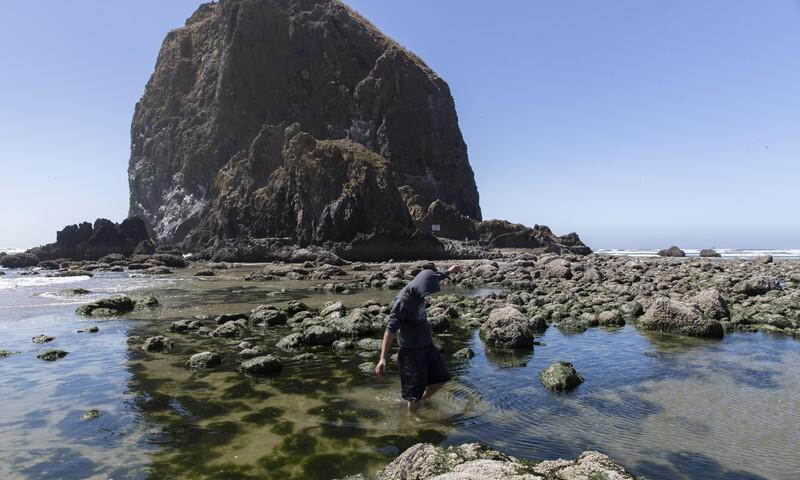
A young man shuffles through the tide pool in front of Haystack Rock in Cannon Beach, Ore.
Miranda Daviduk/OPB
How much time do you have to get out of the way of a tsunami? And what way should you go and how fast do you have to move?
Earthquake experts in the Northwest have said the Cascadia Subduction Zone is due for a large, undersea seismic event — possibly soon — which could trigger a catastrophic earthquake and tsunami along the Oregon Coast. Detailing where people should go and how quickly in the event of an earthquake, is the focus of the latest reports published by the Oregon Department of Geology and Mineral Industries on Thursday.
The reports and accompanying maps cover the key tourist destinations in Clatsop County including Astoria and Cannon Beach, as well as nearby communities of Arch Cape and Falcon Cove.
The “Beat the Wave” modeling reports are lengthy and dense — with detailed maps, hypothetical seismic scenarios and methodological explanations filling nearly 60 pages just for Astoria and its surroundings. Taken as a whole, the reports suggest that different parts of coastal Clatsop County expose residents and visitors to a range of risks, depending on the topography of the area, the arrival time of tsunami waves, and the roads and trails available. The relative safety of tsunami evacuations are further complicated by other variables, including whether the earthquake would cause local landslides or liquefaction, and whether critical roads and bridges would survive the seismic disturbance.
In general, the reports recommend escaping tsunamis on foot, rather than by car, because of the potential for vehicles to be stuck in traffic as water levels rise. They also note the importance of starting to evacuate as quickly as possible once a tremor is felt — though the reports’ modeling assumes it will take people at least a few minutes to start seeking higher ground.
The good news in the two new reports — one on Astoria and the surrounding area, the other on Cannon Beach, Arch Cape and Falcon Cove — is that safe evacuation is possible at a “walk” or “slow walk” pace from many of the more populated areas. However, that’s not the case for one of the most densely populated parts of Cannon Beach: its popular downtown.
“Evacuation distances in downtown Cannon Beach are generally much longer and present a greater challenge,” the report said. “Evacuees must travel at a fast walk (4.1 miles per hour) to reach safety prior to the arrival of the tsunami.”
The report says the need for a brisker pace among evacuees is due to the relative speed of the arriving tsunami and the long distance people would have to higher ground to the south, from the north side of Cannon Beach’s downtown.
Inundation zones for Cannon Beach — shown in the reports as bright yellow and orange areas — cover tourist areas of the city and follow Ecola Creek inland. The orange and yellow inundation areas cling more closely to the rivers and bays in Astoria, leading to shorter evacuation routes for much of that city.
For instance, the Astoria analysis of the downtown area says, “Anyone in this entire area can travel at a minimum speed of slow walk (1.4 miles per hour) and reach high ground ahead of the tsunami. This is due to short evacuation distances and long wave arrivals.”
Other parts of Astoria can be similarly evacuated at a slow walking pace — though the model shows some specific exceptions. Across Youngs Bay in the Jeffers Garden area, residents will have to move more quickly to stay ahead of a tsunami.
“Most of the community can travel at a minimum speed of walk (2.7 mph) and reach high ground ahead of the tsunami,” the report said. “The lone exception to this is Clover Rd where people must travel at a minimum speed of fast walk (4.1 mph).”
That’s because residents of Clover Road have nearly two miles they’d have to travel to reach a safe evacuation spot. For some areas, the report authors recommended building evacuation infrastructure — such as a trail to leave Clover Road’s inundation zone, though modelers acknowledge, “trail construction over Jeffers Slough will be challenging.”


